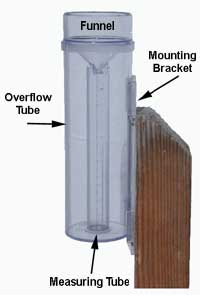(from "The Catch" December 2020, Nolan Doeskin's monthly CoCoRaHS Newsletter)
Each month, more and more of our new recruits are signing up for CoCoRaHS assuming they will be using their often new electronic automated rain gauges. I’m sure more will be receiving these as gifts for Christmas. They are often saddened and perhaps confused by the fact that these gauges don’t “cut the mustard” (where did that phrase come from?) for CoCoRaHS. We believe some continue to use them in CoCoRaHS. There is no doubt they offer advantages. For example, they collect data whether we are home or not and often provide timely important information on rainfall intensity (expressed in inches or millimeters per hour). Furthermore, you don’t even have to go outside in the cold, dark and rain to take a measurement. I have a home electronic weather station myself, and I like it very much. But we don’t routinely use data from these stations for CoCoRaHS and here’s why:
Automated rain gauges are prone to calibration biases. Some perform very well, but others not so much. Without doing a side-by-side comparison, you will never know. (Thanks, by the way, for the several of you who provide ongoing comparative data in your daily comments from both your CoCoRaHS gauge and your electronic gauge – very helpful indeed). Many perform well in light to moderate rains. Heavy rains are a challenge for some electronic gauges. Snow is almost always problematic – even if you have the added feature of a heating element on your gauge.
The CoCoRaHS “Standard” gauge is a scaled down version of the historic U.S. Weather Bureau standard rain gauge used since the late 1800s. The CoCoRaHS gauge is made of sturdy clear plastic and is 12” high (the outer cylinder) and 4” in diameter. By comparison the historic gauge gauge was traditionally made of metal and is 24” tall with a diameter of 8” (see this NWS page for images and additional info). It is sturdy and robust and can catch huge rains and snows – but is expensive, heavy and awkward to use in taking snow core samples. Many years of inter-comparisons have shown the smaller gauge that we recommend compares very favorably –within +/- 2% of the Standard NWS gauge in both rain and snow situations. By comparison, the myriad of available electronic gauges – as a whole – perform with less consistency and often, over time, show a low bias compared to standard manual gauges. This is even the case with modern National Weather Service ASOS (Automated Surface Observation Station).
By all means, enjoy your electronic weather stations. They are awesome and have greatly enhanced the experience of weather watching. But for measuring precipitation, please stick with the manual gauge. The reason professionals across the world admire CoCoRaHS is our data quality and consistency.

